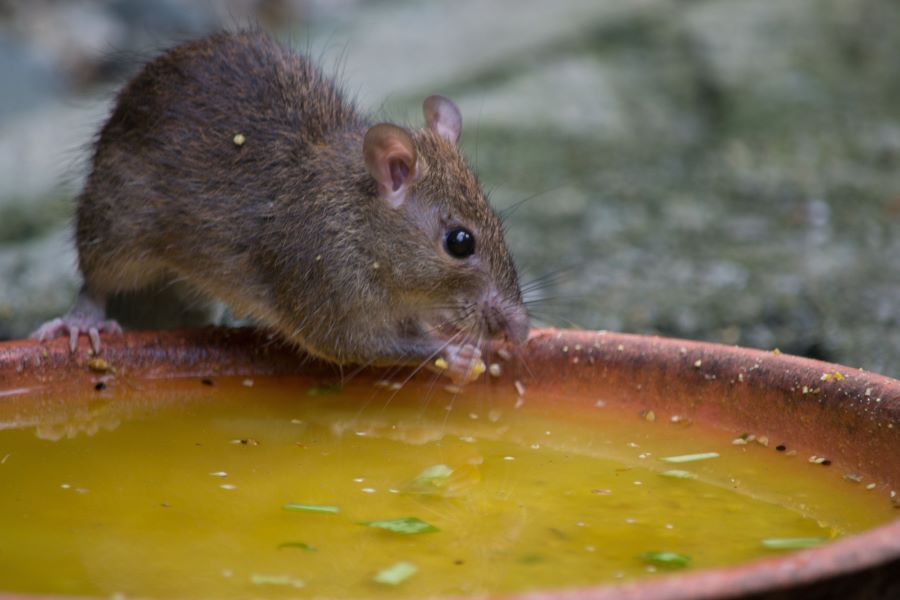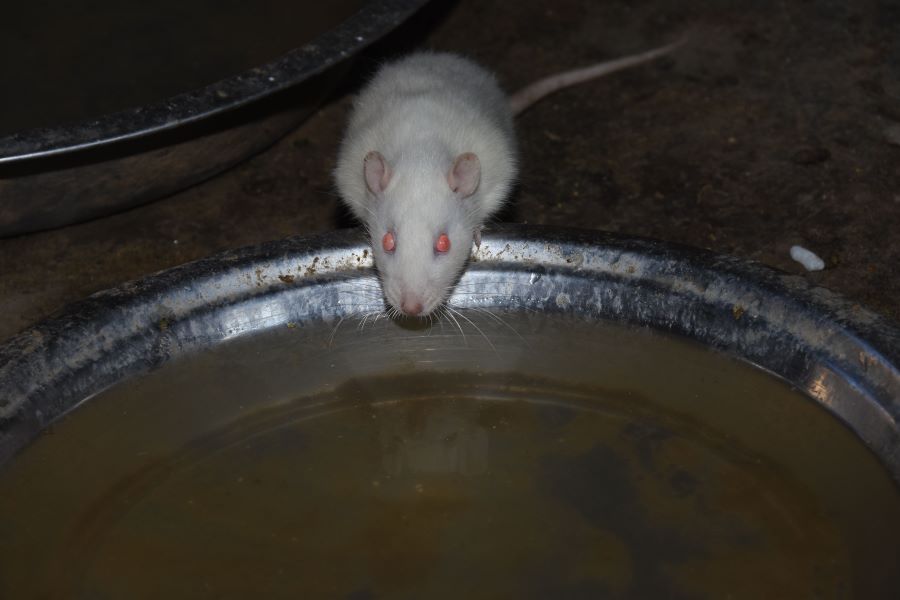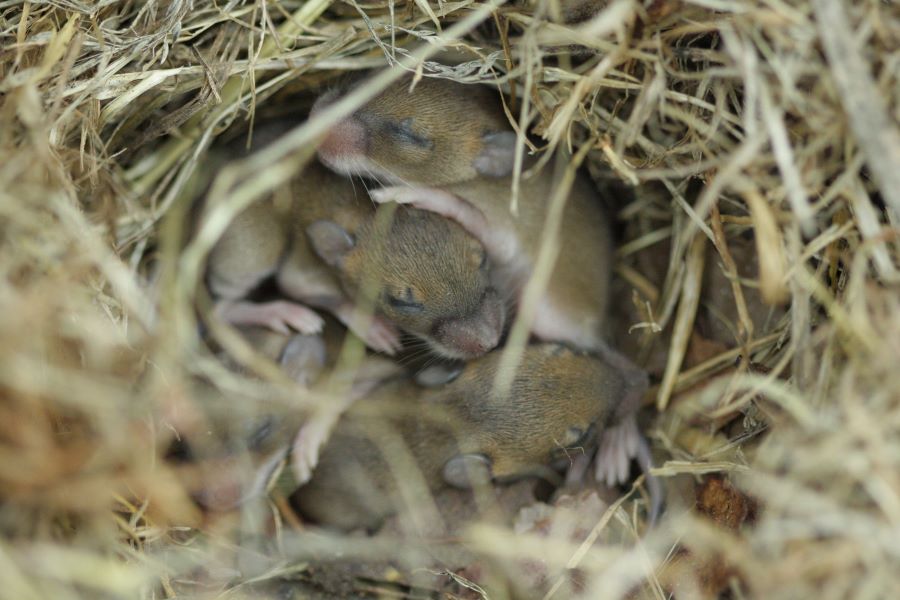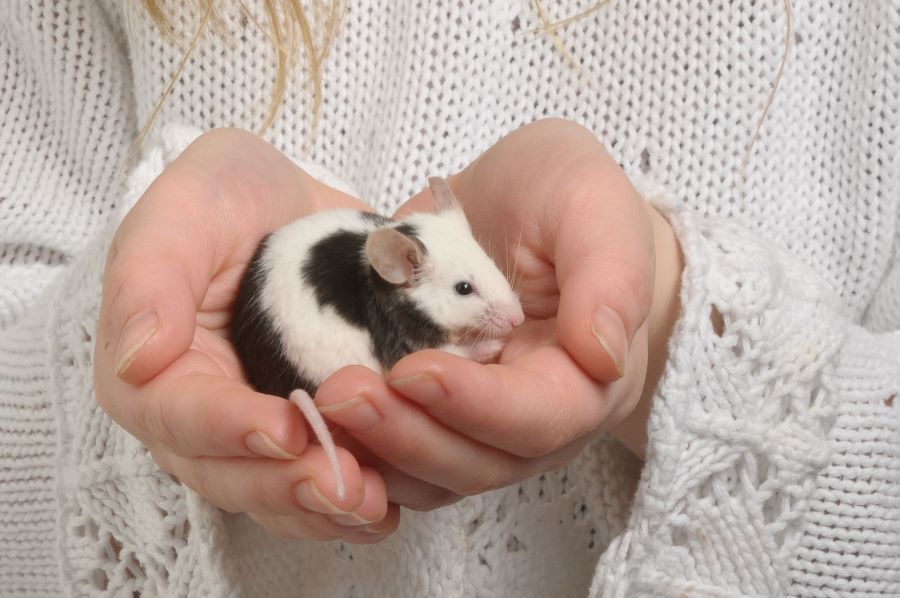Some of the posts on Mercury Pets contain affiliate links to products. That means if you click on that link and then make a purchase, we receive a percentage of the sale. We only recommend products we’ve used and support, and there’s no additional cost to you — the money goes right back into making this site the best it can be! Thanks for reading.

The basics for most animals to survive is food, water and shelter. But how important is water for mice? Do they need it, and how do they find it?
Adult mice drink about 1 tablespoon of water per 4 ounces of body weight daily. They can find this water entirely through the food they eat, and do not require a direct water source. However, they will drink from sources of water when they find them.
For mice in particular here are the water measurements they require per day based on the average weights of adult house mice: [Source]
| Weight (oz) | Amount of Water Daily (tbsp) |
| 0.60 | 0.15 |
| 0.63 | 0.16 |
| 0.67 | 0.17 |
| 0.71 | 0.18 |
| 0.74 | 0.19 |
| 0.78 | 0.20 |
| 0.81 | 0.21 |
| 0.85 | 0.21(2) |
| 0.88 | 0.22 |
So the big picture is, even at the highest average weight mice may only need less than a quarter of a tablespoon of water. How is that even possible?
If Mice Have Food, They Have Water
Mice can actually get most of the water they need to survive from the foods they eat. As long as the mice has access to food, the mouse doesn’t have to actively go search for water sources.
Obviously pet mice who are kept in an enclosure wouldn’t have to go far to search for water so, chances are they will drink water when they want to and when it’s available.
Mice also store food in areas to save for later. Naturally, mice in the wild may not know where the next meal is coming from. If there’s plenty of food in that moment, they may take small portions and hide them in various locations. Due to the very small caloric intake required for mice, small stores of food could last the mouse months!
This is a little different than domesticated mice who will more than likely learn that there will always be plenty of food. They may still attempt to store food because it’s ingrained in their instincts. However, with proper cage cleaning this stores will probably be thrown away before your pet can access them.
Foods that Can Be Sources of Water for Mice
Here are some foods that a rich in moisture that are safe for rat’s to eat:
- Broccoli
- Carrots
- Celery
- Apple
- Melon
- Peaches
- Berries
- Cabbage
- Parsley
- Corn
All these foods are not only safe and tasty for mice, but provide a water source for mice when water may not be available or if you just feel like your mouse is not drinking enough water. Foods how ever should not act as a substitute for clean drinking water [Source].
The Science Behind Mice Needing Little Water
Mice are equipped to deal with chronic water restriction or deprivation. This may be an evolutionary advantage that was developed over time through adaptions that became crucial during certain seasons and in different environments.
According to a study of dehydration parameters and standards for laboratory mice…
“With acute water deprivation, the appearance and attitude of mice deteriorated after 24 h, and weight loss exceeded 15%. Plasma osmolality was increased, and plasma volume decreased with each time interval. Plasma corticosterone concentration increased with duration of deprivation.
Chronic water restriction induced no significant changes compared with ad libitum availability. We conclude that acute water deprivation of as long as 24 h produces robust physiologic changes; however, deprivation in excess of 24 h is not recommended in light of apparent animal distress. Although clearly thirsty, mice adapt to chronic water restriction of as much as 50% of the ad libitum daily ration that is imposed over an interval of as long as 8 d.”
[Source]

What is Dehydration Anorexia in Mice?
Mice do have an adaption to eat less food when water is limited.
But didn’t we just say that mice will eat food to get water from it?
Dehydration anorexia occurs with chronic limited access to water versus acute dehydration in which mice will try to get moisture from “non-water” substitutes [Source].
So why does it work? Think of your body’s fluids as a tall pitcher of water. Then think of all the nutrients in your body as the powder you use to make iced tea. When all the portions are correct, the powder completely dissolves and your drink tastes great.
When you don’t have enough water, but continue to have nutrients from food (the powder in my analogy) your portions will be off and your drink will be too concentrated, your powder won’t completely dissolve, and it’ll taste disgusting.
So let’s say you still want to have your perfect drink, what alteration could you make if you’d can’t add water? To keep your portions correct, you would decrease the amount of powder (or nutrients) you’re adding to the water.
This is what mice due during dehydration anorexia. Mice will intake less food so that their plasma (their mixture of water and nutrients) stays consistent and the portions are accurate. This is their way of maintaining balance within the body – better known as homeostasis.
Do I Need to Give My Mouse Water if They Are Getting it From Food?
So people may think well if my mouse needs so little water, and can get it from all these other sources – should I even bother to put out water for him?
Yes, absolutely yes and a thousand times yes.
All animals should have access to safe clean drinking water 24/7. Just because your mouse can get moisture from the foods they eat, doesn’t mean it’s sufficient for their life functions. There’s also a chance that maybe your mouse isn’t too excited about the melon you’ve left for them and has decided to bury the pieces in their bedding. You may not even realize they are not eating it and not getting water!
If you find a snack that your mouse likes (that’s mouse-friendly) that is a source of moisture and water that’s great. This may be a great option in times you feel like your mouse isn’t drinking enough water, or during times of hotter weather when your mouse’s water demand my be higher. This again should be in addition to a water source, not a substitute.
Water Bottle or Water Bowl for Pet Mice?
That being said, you don’t need a huge water bottle strapped onto the side of the cage. One reason being that there is a very unlikely chance your mouse will need all that water.
The second reason being you’ll have to continue to change the water for it to be clean and fresh – so it may be easier to have a smaller bottle to clean and refill. A small 5 oz or 6 oz bottle will probably be enough and you can change it easily each day.
It is recommended to use a bottle over a water bowel for mice. Mice love to burrow and make dens out of their bedding which they will scatter around and pile up in certain areas.
If you have a water bowel, chances are it will become littered with bedding. Even a bowl that attaches to the side of the cage can become unhygienic from bedding being thrown about. So when in doubt, stick to the bottle.
So the short answer is YES, mice need water. They may not need very much of it, but it is still important and vital for their survival. Although they can be craft and get water from other sources, acute inability to have access to water can cause serious and life-threatening physiological changes in mice.
On the other hand, a mouse who may be in an environment that generally has limited water is better able to survive and cope through adaptations.
All breeds of mice are different, and of course there are variations between domesticated mice we keep as pets and mice that are out in the wild. Our domesticated mice still hold onto some of their adaptations, but the recommendation is to not test out their abilities to cope with limited resources.



